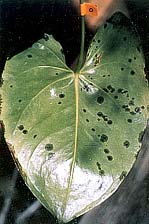
Huettel RN, Kaplan DT and Dickson DW (1986) Characterization of a new burrowing nematode population, Radopholus citrophilus, from Hawaii. Hoogasian C (1990) Anthurium blight threatens state's floral economy. Higaki T and Imamura JS (1985) Volcanic black cinder as a medium for growing anthuriums.
#BACTERIAL BLIGHT APPEARS ON ANTHURIUM SERIES#
Hawaii Institute of Tropical Agriculture and Human Resources, Univ Hawaii Res Ext Series 152 Higaki T, Lichty JS and Moniz D (1994) Anthurium culture in Hawaii. Hayward AC (1972) A bacterial disease of Anthurium in Hawaii. Hawaii Agricultural Statistics Service (1999) Diversified agriculture rankings 1996–97. citri in citrus plant debris and soil in Florida and Argentina. Graham JH, McGuire RG and Miller JW (1987) Survival of Xanthomonas campestris pv. Glandorf DCM, Brand I, Bakker PAHM and Schippers B (1992) Stability of rifampicin resistance as a marker for root colonization studies of Pseudomonas putida in the field. Gilbertson RL, Rand RE and Hagedorn DJ (1990) Survival of Xanthomonas campestris pv. Plant Dis 82: 800–806įukui R, Fukui H and Alvarez AM (1999) Comparison of single versus multiple bacterial species on biological control of anthurium blight. University of Hawaii at Manoa, Honoluluįukui H, Alvarez AA and Fukui R (1998) Differential susceptibility of anthurium cultivars to bacterial blight in foliar and systemic infection phases. In: Fernandez JA and Nishijima WT (eds) Proc. Plant Dis 69: 727įernandez JA, Tanabe MJ, Moriyasu P and Duffy B (1989) Biological control. And ensure you quarantine any new plants for a while to ensure that they are uninfected.Cooksey DA (1985) Xanthomonas blight of Anthurium andraeanum in California. Rubbing alcohol could be utilized as a sanitizing agent. Sanitize all containers and tools just before use. Make certain that there is no standing water in places you grow your anthurium. You may easily spread blight when they're moist.įinally, appropriate sterilization is vital. Next be cautious when walking in between your plants, especially if they're wet. Be careful not to let it touch other plants as it's transported away. Second, immediately get rid of any plants that show signs of disease.


This will reduce the spread of blight from an infected leaf to an uninfected one. Watering with drip irrigation will decrease the amount of water that gets on the foliage. The very first is changing how they are watered. When raising these plants in close proximity there are various things it is possible to do to decrease the transmission of blight. But if you are growing a big quantity of them, you might not have a choice but to keep them nearer together. So if you are growing these plants within your garden you want them spaced as far apart as possible. Water can transport Xanthomonas from an infected plant to an uninfected plant.Ĭertainly if you keep the plants close together, there is a higher possibility of infection than if you keep them far apart.

So if you are growing andrecola you most likely don't need to worry about blight, but if you are raising andreanum, you may well wish to read on.Īppropriate anthurium care is important to hold this harmful menace at bay. Normally, andreanum are susceptible to this illness, whilst andrecola, which are andreanum amnicola hybrids are resistant against it. When an anthurium plant is contaminated it will ultimately die, if you don't manage to clear away infected leaves or flowers before the illness has progressed. A number of, but not all anthurium blossoms are vunerable to a disease known as Xanthomonas blight.


 0 kommentar(er)
0 kommentar(er)
